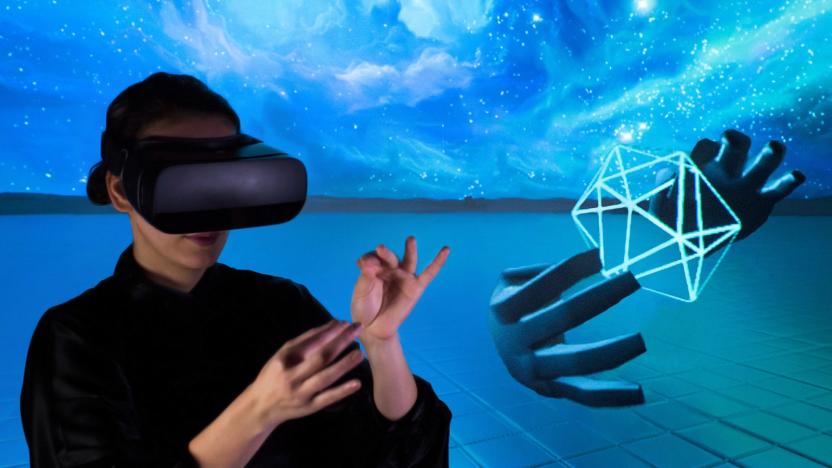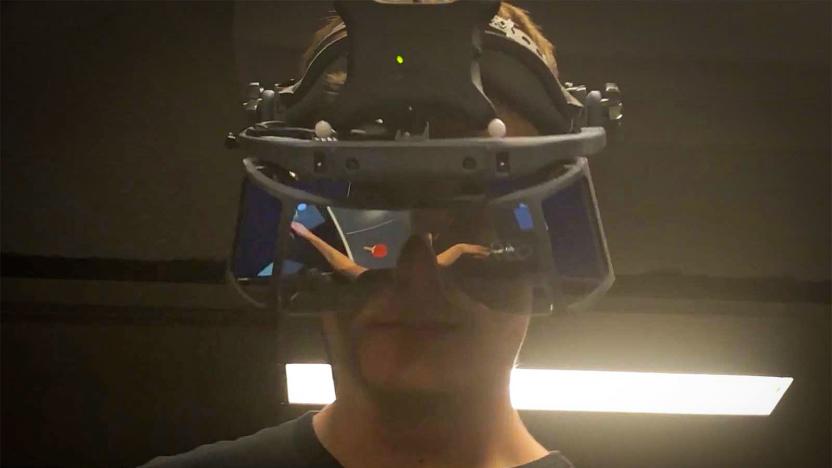TL19LEAP
Latest

VR pioneer Leap Motion reportedly sells to UltraHaptics for $30 million
VR/AR startup Leap Motion has been sold to a rival business named UltraHaptics, according to the Wall Street Journal. The price for the company was reportedly around $30 million -- it was said to be valued at ten times as much in 2013.

Leap Motion shows off AR headset with rousing game of ping pong
If you wanted to demonstrate Leap Motion's low-cost augmented reality headset, how would you do it? Create a flashy, action-packed showcase? Leap Motion has a different idea: an invigorating game of ping pong. The company has crafted a demo that combines the Project North Star headgear with paddle controllers to pit the wearer against an AI opponent at a real ping pong table. It's not mind boggling by any stretch, but it's a good example of a fast, intuitive AR experience that depends on high accuracy. You can juggle the ball and serve it as naturally as you would if it were real. And importantly, there are behind-the-scenes developments that could influence AR going forward.

Leap Motion will bring your hands into mobile VR
Leap Motion has been working on making your interactions in VR as realistic as possible, but it's only been available to desktop or console systems. Now, the company has expanded its scope to mobile devices with its new Mobile Platform, designed for "untethered, battery-powered virtual and augmented reality devices." It has built a reference system of its new sensor and platform on top of a Gear VR, that it says it is shipping to headset makers around the world. Leap Motion is also bringing demos of its Interaction Engine (for natural hand gestures) in this portable medium to major VR events this month.

Leap Motion wants picking up VR objects to feel believable
Virtual reality is more immersive when you can pick up objects with your bare hands, rather than a controller or a pair of wand-style remotes. Leap Motion is one of the frontrunners in this area, having pivoted its candy bar motion-tracking sensor from desktop accessory to VR headset companion. To raise interest in the product -- which you still have to attach manually to an Oculus Rift or HTC Vive -- it's developed a new piece of software called the "Interaction Engine." Available as an add-on for Unity, it promises a more realistic experience while interacting with make-believe objects.

Leap Motion's new motion-sensing tech is built for VR
For several years now, Leap Motion has been working on bringing hand gestures to virtual reality. And it makes sense; using your hands to move digital objects is way more natural than fiddling with a controller. But to do this, you needed to strap one of the company's motion sensor peripherals in front of an existing VR headset, which is a little clunky to say the least. Plus, the sensor was still running the same software built for desktop PCs; a holdover from the days when Leap Motion's main focus was the aforementioned PC accessory. Now, however, the company is ready to take the next leap forward. Today it's announcing Orion, a brand new hardware and software solution that's built just for VR.

Leap Motion is perfecting natural hand gestures for VR
As immersive as virtual reality can be, you're still left holding awkwardly shaped controllers in your hands -- a reminder that you're very much in the real world. But what if instead of hitting A to move a rock, you could just use your hands? That's exactly what Leap Motion, known for its hand-gesture control sensors, has been working on for the past few years. Most recently, it's been working on something called the Interaction Engine, which aims to take things a step further: to make picking up objects in the digital world feel as natural as it does in the real one.

Leap Motion's next sensor is designed specifically for virtual reality
Virtual reality has made huge strides in headgear recently, but developers are still grappling with control. How do we interact with an artificial world in a natural way? There are plenty of devices to answer this: gamepads, the Sixense Stem system and even purpose-built game controllers -- but the folks at Leap Motion think they have a better solution: just use your hands. Independent developers have been strapping Leap's motion controller onto the Oculus Rift since almost day one, but application isn't consistent. Leap Motion wants to fix that, and has announced that its both creating a VR mount for its existing hardware and building a new sensor specifically for virtual reality.

Leap Motion's latest motion tracking tech can see your joints
The Leap Motion controller is a curious little motion sensor, but it isn't always easy to use. The hand-sensing tech has a tendency to lose sight of where your fingers are and almost every application that uses it has its own learning curve. Soon, that might change -- today Leap is launching the public beta for its next generation (V2) tracking software. This free update makes some big promises, including improved resistance to sunlight and infrared interference, better tracking algorithms and, best of all, the ability to track individual joints. We dropped by the company's San Francisco office to try it out and found the update to be a significant improvement.

Leap Motion controller review
When the Leap Motion controller was revealed to the world, it brought with it the promise of a new and unique computer user experience. And, ever since we first got to see what the Leap Motion controller could do -- grant folks the ability to interact with a computer by waving their fingers and fists -- we've wanted one of our own to test out. Well, our wish was granted: we've gotten to spend several days with the controller and a suite of apps built to work with it. Does the device really usher in a new age of computing? Is it worth $80 of your hard-earned cash? Patience, dear reader, all will be revealed in our review.%Gallery-194274%






